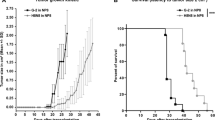Abstract
This paper studies the heterogeneity of metastatic potential of murine cervical carcinoma (U14). Two cell lines, P11–90 and L10–90, were established from a pulmonary metastatic substrain (U14AP11) and a lymphatic metastatic substrain (U14AL10), which were selected from U14 in vivo after 11 and 10 passages, respectively. The biologic differences between the two cell lines are as follows. (1) The cells of the P11–90 line grow more rapidly compared with the L10–90 line. From the 40th passage the medium pH was different. (2) The median number of chromosomes in P11–90 and L10–90 was 72 and 64, respectively; the rates of gap aberration were 88% and 78%, respectively. (3) The number of T lymphocytes and T helper lymphocytes in the peripheral blood from hosts with P11–90 were higher than that of hosts transplanted with L10–90, but the number of B lymphocytes in the latter was larger than that in the former. (4) The metastatic potential of each cell line partially decreased compared to the relative tumor substrain, but their organ preference still remained and the transplant locations, axillary or footpad, had a prominent influence on their metastatic behavior. To observe the effects of metastatic target organs on the metastatic phenotypes of tumor cells, as well as to explore a method for the establishment and maintenance of the metastatic organ preference of tumor cells, conditioned medium (CM) from pulmonary or lymphatic node diploid cells was added to the culture medium of P11–90 and L10–90. Two sublines, P + P11–90 and Ln + Lon10–90, were thus established. Using stereological methods we found that the majority of P + P11–90 cells became larger and their nuclei also increased in size compared with their parental lines, but the majority of Ln + L10–90 cells became smaller in size, though the nuclei were enlarged. The pulmonary metastatic rate and lymphatic metastatic rate of P + P11–90, as well as the lymphatic metastatic rate of Ln + L10–90,, were restored dramatically. The results suggest that by taking advantage of the interaction between tumor cells and the CM of host cells the metastatic potential of tumor cell lines can be maintainedin vitro. Our work may offer an experimental model for the manipulation of metastasis of cell lines coming from the same parent strain but with different metastatic potentials. Our study demonstrates that although the specific metastatic tendencies of the cell lines decrease after multiple passages, these propensities are restored after passages with CM from normal lung and lymph node tissue.
Similar content being viewed by others
References
Nicolson, GL, 1993, Cancer progression and growth: relationship of paracrine and autocrine growth mechanisms to organ preference of metastasis.Exp Cell Res,204, 171–80.
Poste, G and Fidler, IJ, 1980, The pathogenesis of cancer metastasis.Nature,283, 139–46.
Fidler, IJ and Knipke, ML, 1977, Metastasis results from preexisting variant cells within a malignant tumor.Science,197, 893–5.
Patterson, MK, 1979, Measurement of growth and viability of cells in culture.Meth Enzymol,58, 141–52.
Gundersen, HJG, Bendtsen, TF, Korbo, L,et al. 1988, Some new, simple and efficient stereological methods and their use in pathological research and diagnosis.APMIS,96, 379–94.
Pathak, S, Hsu, TC, 1985, Cytogenetic identification of interspecific cell line contamination: procedures for noncytogeneticist.Cytobios,43, 101–14.
Pathak, S, 1976, Chromosome banding techniques.J Report Med,17, 25–8.
Muller, J, Burn del Re, G, Buerki, H, Keller, HU, Hess, MW, Gottier, H, 1975, Non-specific acid esterase activity: a criterion for differentiation of T and B lymphocytes in mouse lymph nodes.Eur J Immunol,5, 270–74.
Macedo, HW and Quirico-Santos, T, 1991, Nonspecific esterase staining of lymphocyte subsets in leprosy.Exp Pathol,41, 50–2.
Fu, T, 1980, Cytogenetic characteristics of uterine cervical carcinoma U14.Bai Qui En Med Univ J Med,6, 2–15.
Yuan, XM and Zhang, Zn, 1991, Micronuclei in the tumor substrain cells with different metastatic potential.Dalian Med Coll J Med,1, 60–5.
Szaniawska, B, Majewski, S, Maninski, MJ, Noremberg, K, Swierz, M and Janik P, 1985, Stimulatory and inhibitory activities of lung-conditioned medium on the growth of normal and neoplastic cellin vitro.J Natl Cancer,75, 303–16.
Price, JE, Naito, S and Fidler, IJ, 1988, Growth in an organ microenvironment as a selective process in metastasis.Clin Exp Metastasis,6, 91–102.
Yuan, XM and Zhang, Zn, 1991, Experimental study on interaction of different metastatic potential H22 cells with cryostat section of host tissuesin vitro.Dalian Med Coll J Med,1, 55–60.
Ossowski, L and Reich, E, 1980, Loss of malignancy during serial passage of human carcinoma in culture and discordance between malignancy and transformation parameters.Cancer Res,40, 2310–15.
Horak, E, Darling, DL and Tarin, D, 1986, Analysis of organ-specific effects on metastatic tumor formation by studiesin vitro.J Natl Cancer Inst,75, 913–22.
Nicolson, GL and Dulski, KM, 1986, Organ specificity of metastatic tumor colonization is related to organ-selective growth properties of malignant cells.Int J Cancer,38, 289–94.
Nicolson, GL, 1987, Differential growth properties of metastatic large cell lymphoma cells in target organ conditioned medium.Exp Cell Res,168, 572–77.
Chackal, RM, Niemeyer, C, More, M and Zetter, BR, 1989, Stimulation of human prostatic carcinoma cell growth by factors present in human bone marrow.J Clin Invest,84, 43–50.
Author information
Authors and Affiliations
Rights and permissions
About this article
Cite this article
Yuan, X.M., Xie, F.P., Lu, Z.B. et al. The establishment of two cell lines from a mouse uterine cervical carcinoma (U14) and their metastatic phenotype changes. Clin Exp Metast 13, 463–473 (1995). https://doi.org/10.1007/BF00118185
Received:
Revised:
Issue Date:
DOI: https://doi.org/10.1007/BF00118185




